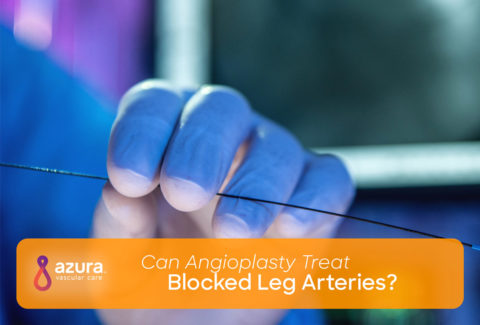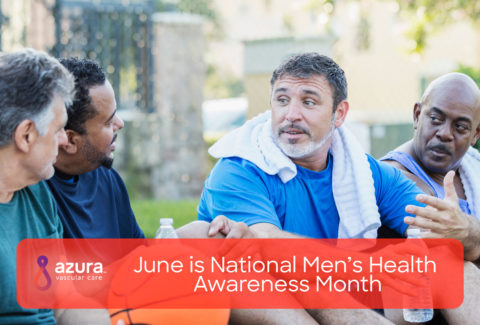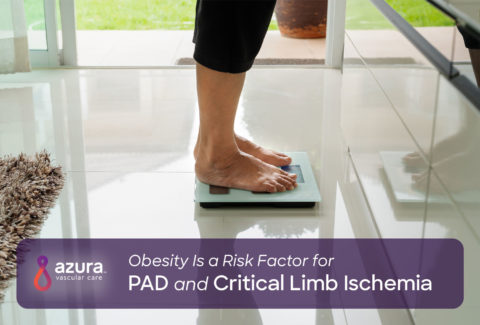
If you smoke, you’ve probably heard about all of the health risks associated with the habit. But did you know that smoking can cause peripheral artery disease (PAD), which may lead to vascular amputation?
PAD starts when arteries are narrowed due to the accumulation of plaque, and decrease or prevent blood flow to your legs. Cigarette smoking is a cause of PAD, in addition to lack of exercise, diabetes, high cholesterol, high blood pressure, and blood vessel inflammation.
Linking Smoking and PAD
The chemicals in tobacco affect your blood cells and how your heart and blood vessels function. This can increase your risk of developing atherosclerosis, a condition in which plaque builds up in the arteries. Over time, plaque can harden and cause your arteries to narrow, limiting the flow of oxygen-rich blood to your organs and other parts of your body. i
There is a very strong correlation between smoking and PAD; approximately 90 percent of patients with PAD have a history of smoking. ii In fact, smoking even half a pack of cigarettes a day may increase your risk of having PAD by up to 50 percent. iii
Any amount of smoking, even occasionally, damages the heart and blood vessels. Secondhand smoke also can hurt the heart and blood vessels, greatly increasing the risk of heart attack and death in adults. ii
Why You Should Quit Smoking

Smoking increases the risk of PAD by up to six times and makes the symptoms worse. iv
By quitting smoking, PAD patients can increase their chances of long-term survival. In fact, one study found that 82 percent of former smokers were still alive after 10 years, compared with only 46 percent of patients who continued smoking. ii
Regardless of how much or how long you’ve smoked, quitting has a variety of benefits, including reducing your risk of developing heart disease, having a stroke, and lowering your risk of atherosclerosis, blood clots and PAD. i
Risk Factors for PAD
It’s estimated that 8.5 million Americans have PAD. iv
PAD risk factors include: iv
- Smoking
- High blood pressure
- Atherosclerosis
- Diabetes
- High cholesterol
- Over the age of 60
While PAD can occur equally in men and women, African Americans, Hispanics and Native Americans are at greater risk. iv, v
Symptoms of PAD
The most common symptom of PAD is claudication, defined as pain, aching or cramping in the buttock, hip, thigh or calf while walking, with pain subsiding with rest. However, up to 40 percent of PAD patients experience no leg pain and it often goes misdiagnosed. iv
Your leg may show signs of PAD, including: iv
- Muscle atrophy
- Hair loss
- Smooth, shiny skin
- Skin that is cool to the touch, especially if accompanied by pain while walking
- Decreased or no pulse in the feet
- Ulcers or sores on the legs or feet that aren’t healing
- Cold or numb toes
PAD and Vascular Amputation
For patients with PAD and other forms of atherosclerosis, plaque formations can grow in the artery and significantly reduce the flow of blood. When a plaque blockage hardens or becomes brittle, it may rupture, causing a blood clot to form. A clot may completely block the artery, which is particularly worrisome if the blockage occurs in the arteries in the legs. vi In fact, total loss of circulation to the legs or feet can cause gangrene, which may require amputation. vi
About five percent of patients with intermittent leg pain who don’t seek treatment require lower-extremity amputation. In extreme cases, critical limb ischemia (CLI) occurs, requiring amputation for 20 percent of patients. vii In other words, seeking treatment for PAD is critically important if you suspect that you have the condition.
Want to find out now if you may be at risk for PAD? Call 844-LEG-DOCS (534-3627) to schedule an appointment with a vascular specialist today.
Sources:
i National Heart, Lung, and Blood Institute. Smoking and your heart. https://www.nhlbi.nih.gov/health-topics/smoking-and-your-heart (accessed April 3, 2018)
ii Lu JT, Creager MA. The relationship of cigarette smoking to peripheral arterial disease. Rev Cardiovasc Med. 2004 Fall;5(4):189-93. Review. PubMed PMID: 15580157. http://medreviews.com/sites/default/files/2016-11/RICM_54_189_0.pdf (accessed April 3, 2018)
iii Vascular Disease Foundation. Life Saving Tips About… Smoking and PAD http://vasculardisease.org/flyers/lifesaving-tips-on-smoking-and-pad-flyer.pdf (accessed April 3, 2018)
iv Centers for Disease Control and Prevention. Peripheral Arterial Disease (PAD) Fact Sheet https://www.cdc.gov/dhdsp/data_statistics/fact_sheets/fs_pad.htm (accessed April 3, 2018)
v http://togetheragainstlimbloss.com/
vi American Heart Association. About Peripheral Artery Disease (PAD) http://www.heart.org/HEARTORG/Conditions/VascularHealth/PeripheralArteryDisease/About-Peripheral-Artery-Disease-PAD_UCM_301301_Article.jsp#.WsPeuJch3IU (accessed April 3, 2018)
vii Swaminathan, A., Vemulapalli, S., Patel, M. R., & Jones, W. S. (2014). Lower extremity amputation in peripheral artery disease: improving patient outcomes. Vascular Health and Risk Management, 10, 417–424. https://www.ncbi.nlm.nih.gov/pmc/articles/PMC4107174/ (accessed April 3, 2018)



